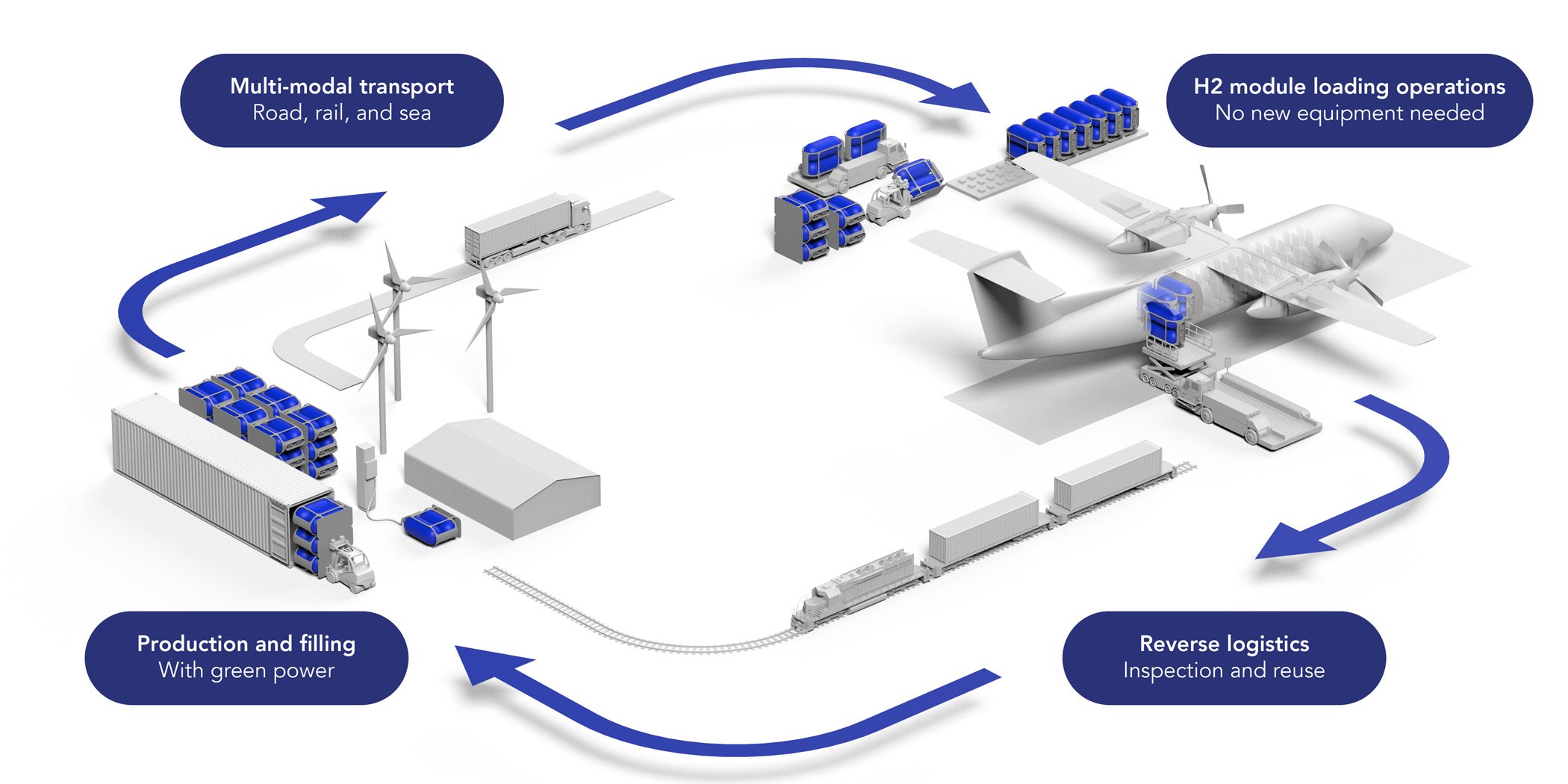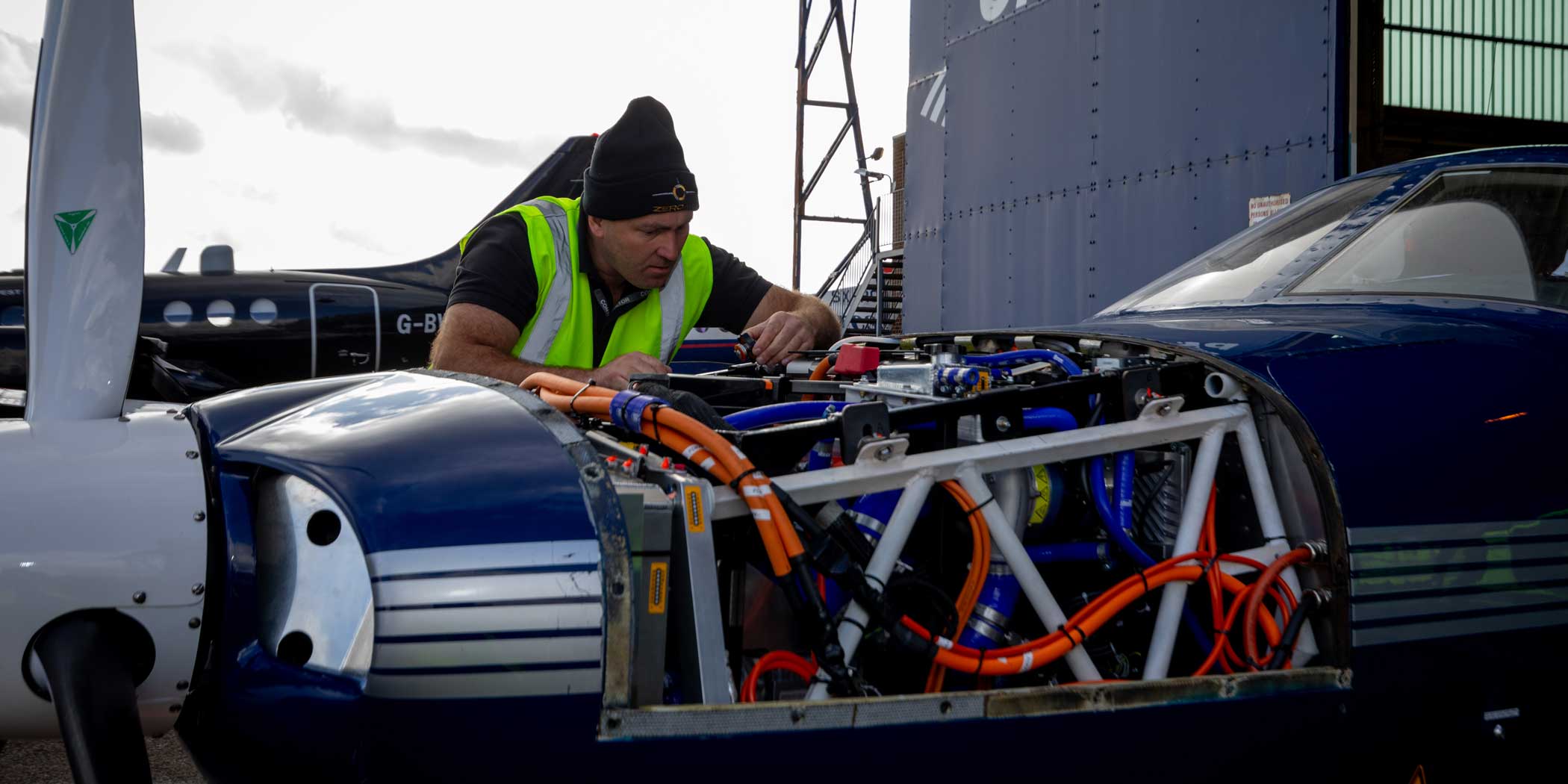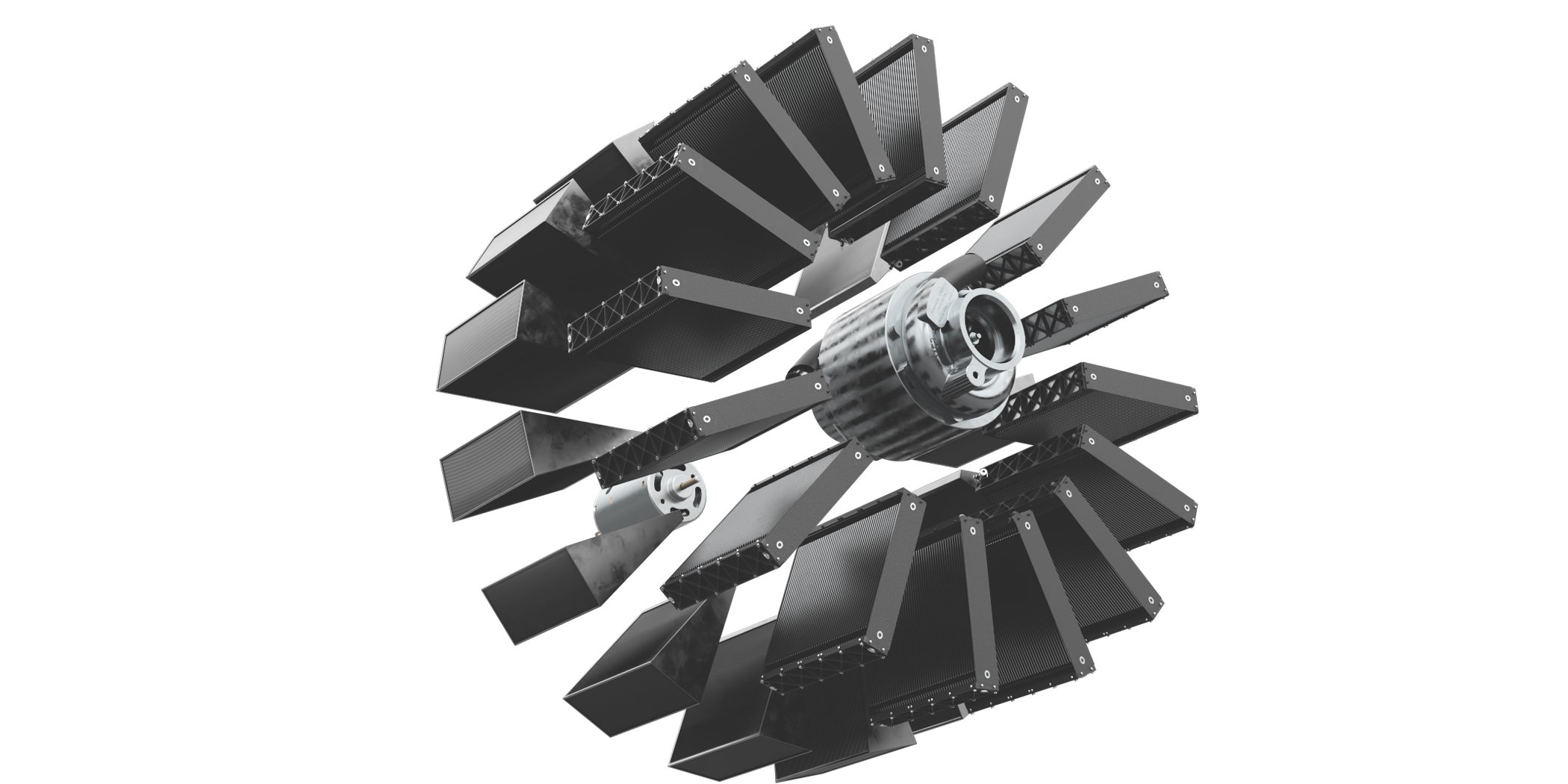Click Here to View This Page on Production Frontend
Click Here to Export Node Content
Click Here to View Printer-Friendly Version (Raw Backend)
Note: front-end display has links to styled print versions.
Content Node ID: 404135
While much of the discussion about how to reduce aviation’s carbon footprint has focused on the availability of sustainable aviation fuel (SAF) and when and how electric aircraft may be unshackled from the limits of battery technology, hydrogen has been quietly moving up the future propulsion agenda. However, hydrogen has been gaining momentum for some time in other sectors of transportation, such as road, rail, and marine vehicles, and is increasingly being viewed as a viable longer-term alternative to fossil fuel. Some of the more bullish pioneers in the field are claiming they could have hydrogen-powered aircraft approved for service as soon as 2025 or 2026.
As recently as early 2020, the use of hydrogen in aviation seemed like something of a fringe research activity. The broad consensus seemed to be that all-electric or hybrid-electric propulsion should be the primary focus for smaller aircraft, but that for anything with more than 20 or so seats the green priority should be making existing turbofans, turboprops, and piston engines less gas-guzzling and pressing for the widespread availability of sustainable aviation fuels to burn in existing powerplants.
While it certainly doesn’t merit all the credit for changing this outlook, Airbus’s September 2020 announcement that it is actively pursuing plans to bring hydrogen-powered airliners into commercial service around 2035 undoubtedly raised the profile of the technology. The European aerospace group is considering three design options under a project designated ZeroE and intends to choose which technology platform to advance in 2024.
The most novel of the three designs shows a blended-wing airframe that Airbus indicated would be able to carry up to 200 passengers on flights of around 2,000 nm. The exceptionally wide fuselage, in which the wing merges with the main section of the aircraft, would provide space for a cabin as well as for hydrogen storage and distribution. The design builds on the Maveric model that Airbus has been working on in stealth mode since June 2019.
Airbus also presented a more conventional narrowbody model that would carry between 120 and 200 passengers on sectors of around 2,000 nm. The propulsion system would be based on a pair of modified gas turbine engines powered by liquid hydrogen that would be stored and distributed via tanks located behind the rear pressure bulkhead. The design features swept-back outer wing surfaces.
The third design is a 100-seat twin turboprop. It too would feature modified gas turbines fueled by hydrogen and would fly to a range of up to around 1,000 nm.
According to chief technology officer Grazia Vittadini, her engineering team expects to have a hydrogen ground demonstrator ready by 2021 to help it to address complex technology risks around the ecosystem for hydrogen power, such as the fuel’s volume and cryogenic (low temperature) characteristics. Addressing a March 30 webinar, Airbus CEO Guillaume Faury reiterated the company’s commitment to hydrogen, while acknowledging the challenges in ensuring adequate supplies and infrastructure for the new fuel, which he said was akin to those already being faced by the industry for sustainable aviation fuel.
In fact, Paul Eremenko, former Airbus chief technology officer and CEO of its ACubed innovation division, believes that he has a solution to the logistical challenges associated with hydrogen fueling of aircraft. He formed Universal Hydrogen in early 2020 with a concept of operations that involves delivering refillable hydrogen capsules directly from fuel production facilities to aircraft.

The hydrogen capsules, which Eremenko has compared to Nespresso coffee pods, will be loaded into the rear of the aircraft and installed in a compartment that would replace the last two rows of passenger seats. Plumbing lines will run from the capsules through the aircraft’s dorsal fins into each of the two nacelles where fuel cells and electric motors would be installed to power the aircraft’s existing propellers.
Initially, the California-based company is looking to convert existing 40- to 60-seat regional airliners such as the Bombardier Dash 8 or ATR 42 under a supplemental type certificate. It believes that its propulsion system would be able to support scheduled services for routes of up to 550 nm. Test flights are due to begin in 2023, with a target date for initial commercial operations in 2025.
Universal Hydrogen is partnered with energy distribution group Plug Power, which is already providing hydrogen fuel cell stack technology for ground-based e-mobility applications, including fork-lift trucks and other vehicles. In March, the company made an initial $1 million investment in Universal Hydrogen and the partners expanded their alliance with a global supply agreement for Plug Power to distribute hydrogen supplies to aircraft.
Initially, the agreement calls for the supply of around 500 tons of hydrogen each day from five distribution points across the U.S. by 2024. This volume is roughly equivalent to a million gallons of Jet-A fuel.
Plug Power says that hydrogen will enter the aviation market on a more affordable basis than existing sustainable aviation fuels, which are still considered to be too costly and hard to source by many aircraft operators. “When you think about [the price of] renewable fuels at four cents per kilowatt-hour, it’s clear that green hydrogen can be produced at prices equivalent to or below fossil fuel in the near term,” Plug Power’s CEO Andy Marsh told AIN. “Universal Hydrogen’s approach is a pragmatic, near-term plan to bring green hydrogen to one of the hardest-to-decarbonize sectors—air travel.”
ZeroAvia is another from the new breed of hydrogen pioneers and, based on the scale of development work already completed, it is arguably the front-runner. On March 31, the California-based start-up announced plans to develop a 50-seat airliner to be powered by hydrogen. Its work will be supported by a $24.3 million capital injection with new investors including British Airways, along with Horizons Ventures and existing backers Breakthrough Energy Ventures, Ecosystem Integrity Fund, Summa Equity, Shell Ventures, and Systemiq. British Airways has not made a specific commitment to including hydrogen-powered aircraft in its fleet, but ZeroAvia claims to already have letters of intent from 15 undisclosed airlines.

According to ZeroAvia, which has now raised nearly $74 million, including $53 million in private investment and a UK government grant of around $16.3 million, it is aiming to get a 50-seat aircraft into commercial service by 2026, using its 2 MW powerplant to convert existing regional airliners, such as the ATR42 and Dash 8. It believes that by 2030, a 100-seat airliner could be run on a more powerful version of its technology.
Currently, ZeroAvia is working on integrating a 600 kW hydrogen-electric powertrain with an aircraft seating up to 19 passengers, such as the Dornier Do228 twin-turboprop model that it is using as a testbed. The company is aiming to bring this to market by 2024 with a range of around 435 nm.
Based on its grant from the UK government’s Department for Business, Energy and Industrial Strategy (BEIS), issued through the Aerospace Technology Institute and Innovate UK, ZeroAvia is basing its development work at Cranfield in England. Its efforts to date have been founded on converting smaller aircraft, such as the six-seat Piper M Series, which it has already flown. Now the company is preparing to conduct a flight of around 70 miles from Cranfield to Kemble airfield in southern England.
Later this year, it aims to conduct a flight of around 250 miles from the Orkney Islands to the Scottish mainland. In the Orkney Islands, the European Marine Energy Centre has developed a process for making hydrogen fuel to support aviation applications. Working with its partner Fuel Cell Systems, it intends to distribute hydrogen with a mobile system consisting of a re-deployable modular electrolyzer, a trailer-mounted air compressor, and a 305-bar refueling truck.
Meanwhile, another California-based start-up called HyPoint has built the first working prototype of its turbo air-cooled hydrogen fuel cell system for aircraft. The company says it will begin delivering full-scale versions of the technology to partners in 2022, supporting plans for both new eVTOL aircraft and the conversion of existing models to hydrogen power.

According to HyPoint, its system’s performance will outstrip existing fuel cells by delivering 2,000 watts per kilogram of specific power and an energy density of 1,500 watt-hours per kilogram. The company says that its competitive edge over rival approaches is based on a decision to use compressed air for both cooling and oxygen supplies for a high-temperature fuel cell system that it says weighs just a third as much as comparable liquid-cooled systems.
In January, GKN Aerospace announced that it is leading a collaboration between industry and academia to develop a hydrogen propulsion system for what it calls “sub-regional” aircraft. Initially, the H2GEAR system would power new and existing aircraft seating up to 19 passengers, but the company says it could subsequently be scaled up for use on larger airliners.
The UK-based project is backed by a £54 million ($73 million) investment evenly shared between GKN, the government’s BEIS department, and partners including fuel cell specialist Intelligent Energy, electric motors and control systems group Aeristech, Newcastle University, the University of Manchester, and the University of Birmingham.
The proposed system will convert liquid hydrogen to electricity in fuel cells. This will power electric motors that will drive either ducted fans or propellers.
According to GKN, the first hydrogen-powered aircraft could be ready to enter service in 2026. The company, which is a tier-one supplier to several leading airframers, including Airbus, says it has had contact with several unnamed aircraft manufacturers, as well as start-ups and also airlines.
In France, the government is also strongly backing a switch to hydrogen power and has established a new council as the basis for work with various industries. In February, Airbus, Air France-KLM, airports group ADP, and the Choose Paris Region development agency has called for expressions of interest to create so-called hydrogen hubs at Paris airports to fuel future hydrogen-powered aircraft. The partners say the initiative is a response to the European Commission's goal to create the conditions for hydrogen-powered airliners to enter commercial service from 2035.
In February, the French government awarded a grant of almost $1 million to Avions Mauboussin, which is developing a new eSTOL aircraft. The start-up is developing what it calls its Zephyr hybrid hydrogen propulsion system to power a two-seat light aircraft called the Alerion M1h and the six-seater Alcyon M3c, which it aims to bring to the market by 2026 and 2028, respectively. It also intends to offer the technology to other aircraft developers.
The new FutureFlight.aero resource from AIN covers all aspects of new aviation technologies and business models, including new propulsion methods. To learn more about this exclusive news and information platform, and to access our database, sign up for a trial subscription.